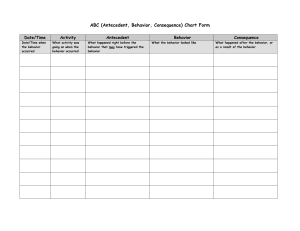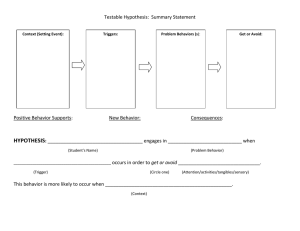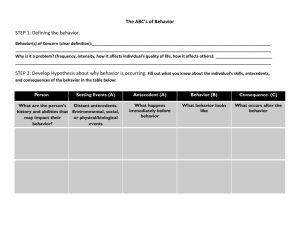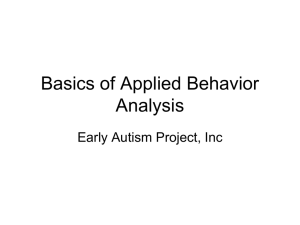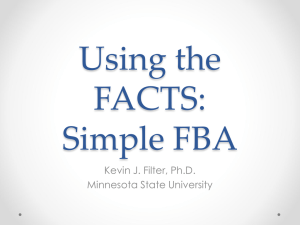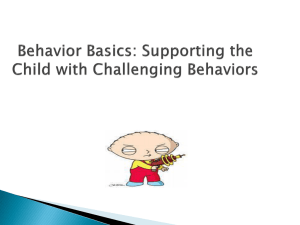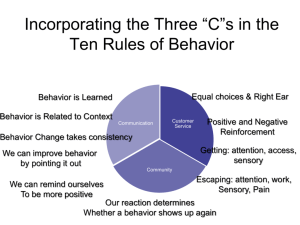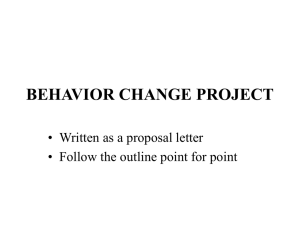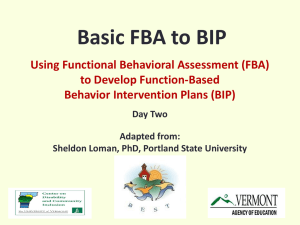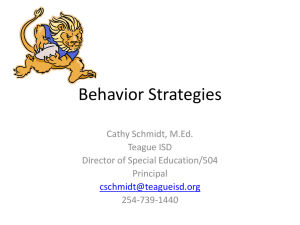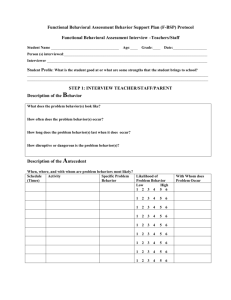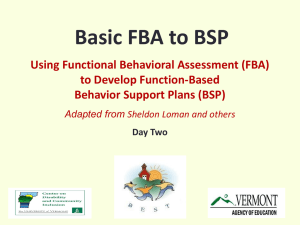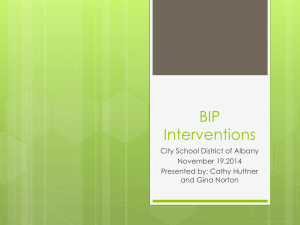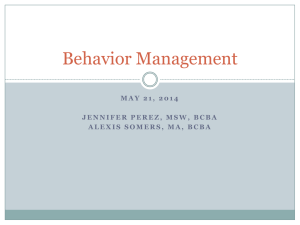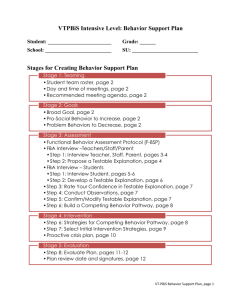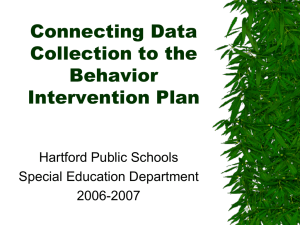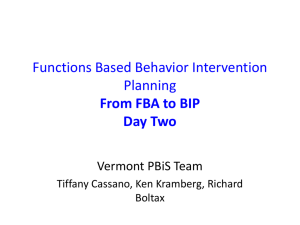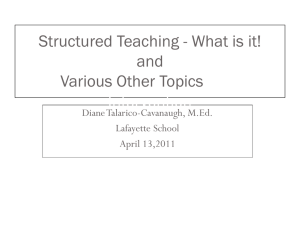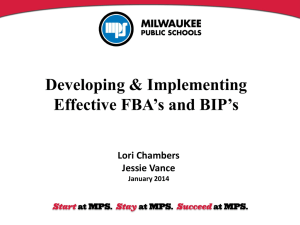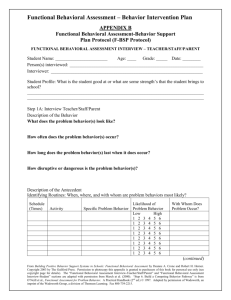FUBA/BIP - PBworks
advertisement
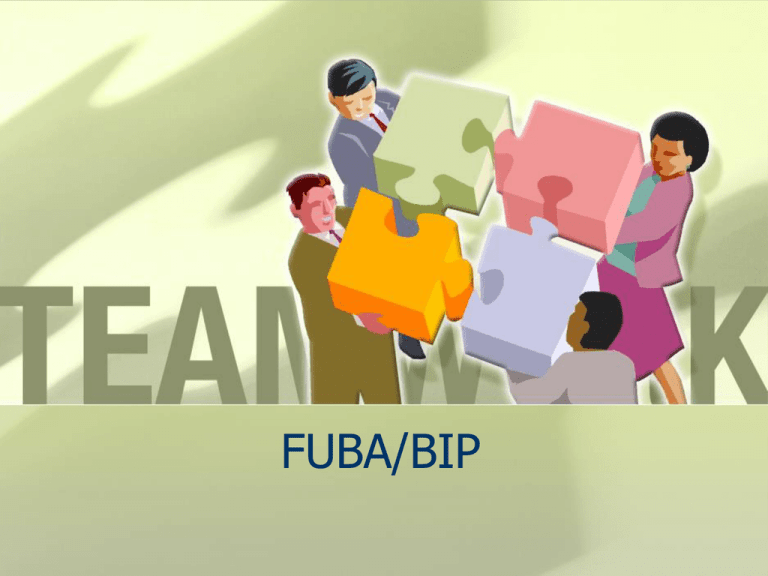
FUBA/BIP The KISD Website How do we get there? http://kentisdse.pbworks.com/PositiveBehavior-Support Template, FUBA/BIP examples, Data collection templates, Reinforcer considerations Teamwork Teamwork Roles Facilitator Note Taker Time Keeper Positive Nag (Per START recommendations) Section 1: Demographics Student Name Grade Date of Birth School District Date Team Members Section 2: Resilience Factors What gives the student the courage to come back each day? What are his/her contributions or interests? Section 3: Data Collection Checklists Do you have enough data to accurately complete the information on this form? Record Review Behavioral Logs Discipline Reports Rating Scales Consultant Observation ABC Forms Staff Direct Observation Reports Section 4: Problem Identification Problem Identification List all of the “concerning” behaviors that are observable and measureable. Remember the 5-10 minute time limit!...Do not dwell on stories. Don’t worry if the behaviors mentioned sound similar– write everything down. In the last 2 minutes of the problem identification – cluster the behaviors. Prioritize the most interfering behavior. Section 5: Problem Specification List the behaviors based on rank Use your data to answer: How Often Intensity Duration Longevity Situation Variables Section 6: Problem Behavior Analysis Antecedent Behavior Describe the problem behavior and how often it occurs. Blurts out 10 times per hour Consequence Section 6: Problem Behavior Analysis Antecedent Behavior When, where, with whom, during a what activities? Describe the problem behavior and how often it occurs. Mr. Smith’s 3rd hour resource room math class, written math assignments, (most difficult academic area) Blurts out 10 times per hour Consequence Section 6: Problem Behavior Analysis Antecedent Behavior Consequence When, where, with whom, during a what activities? Describe the problem behavior and how often it occurs. What did staff do? How did the class respond, or how did the student react? Mr. Smith’s 3rd hour resource room math class, written math assignments, (most difficult academic area) Blurts out 10 times per hour Teacher models appropriate language and gives help. Section 7: Positive Behavior Analysis Remember : look at where the POSTIVE behavior will most likely and least likely occur Adults Peers Certain Activities Settings Time of Day Other…(i.e. home issues, bus, medication, etc). Section 8: Function & Hypothesis What function is the behavior serving? What is the student trying to: GET AVOID OR Section 8: Function & Hypothesis ACCESS/GET Internal: emotional, communication, control, revenge, sensory, auditory, visual External: attention, tangibles, activities Section 8: Function & Hypothesis AVOID/ESCAPE Internal: emotional, psychological, sensory, auditory, visual External: setting, task, activity, person(s), academic Section 8: From the information you have gathered write your hypothesis statement… When [this] occurs [antecedent /setting, events], the student does [this] [function of the behavior]. Include all relevant factors that influence the behavior in your hypothesis. Behavior Support Plan Behavior Support Plan Desired Behavior 6 (VII) Setting 3 (VII) Antecedent 2 (VI) Problem Behavior 1 (VI) Replacement Behavior 8 Consequence 7 (VII) Consequence 4 (VI) Function 5 (VIII) Behavior Support Plan BRAINSTORM Remember all ideas are good ideas. On a white board…list all ways to teach the replacement behavior. Consider: 1. The setting – how can you adjust the setting to help teach the new behavior? 2. The antecedent -- what strategies can be utilized to help teach the new behavior? 3. The consequence – how can consequences be managed to ensure the student receives reinforces for positive behavior, not problem behavior? Section 9: Implementation & Evaluation Supports for Team Members What do your team members need in order to ensure success for the behavior plan? Section 9: Implementation & Evaluation Action Plan for Implementation/Data Collection Who? What? When? Include: Status/Follow Up Your Turn… 10 Minute Break Student Profile This student is a 6th grade general education male student. Had extreme difficulty in unstructured settings Very poor impulse control Has ADHD – not on medication, several meds. tried with little success Average to Above Average IQ When engaged in class…would work hard Willingness to help struggling students in class Student Profile Student had a total of 15 serious discipline referrals throughout his 6th grade year. 3 threats, 5 physical endangerment, 3 bullying incidents, 2 harassment, 1 act of disruption, 1 poor treatment of a sub, 2 lewd or profane incidents. Student Profile… “Mini – behavior plans were written throughout the year…(i.e. individual time spent with admired adults, walked from class to class by an adult, extended time spent in responsibility room, given extra work, given less work, allowed to work with chosen partners…) Continuous contact with outside therapist/parents Teachers collected ABC data observations for 3 weeks before this behavior plan.
